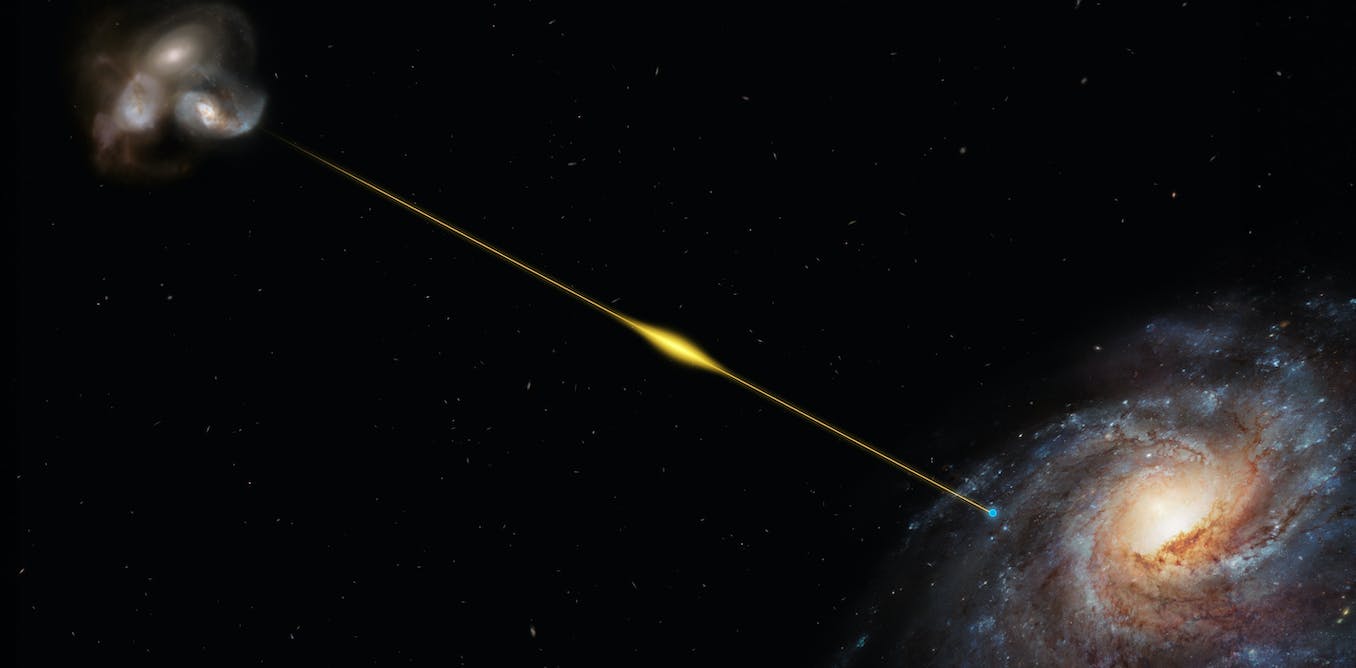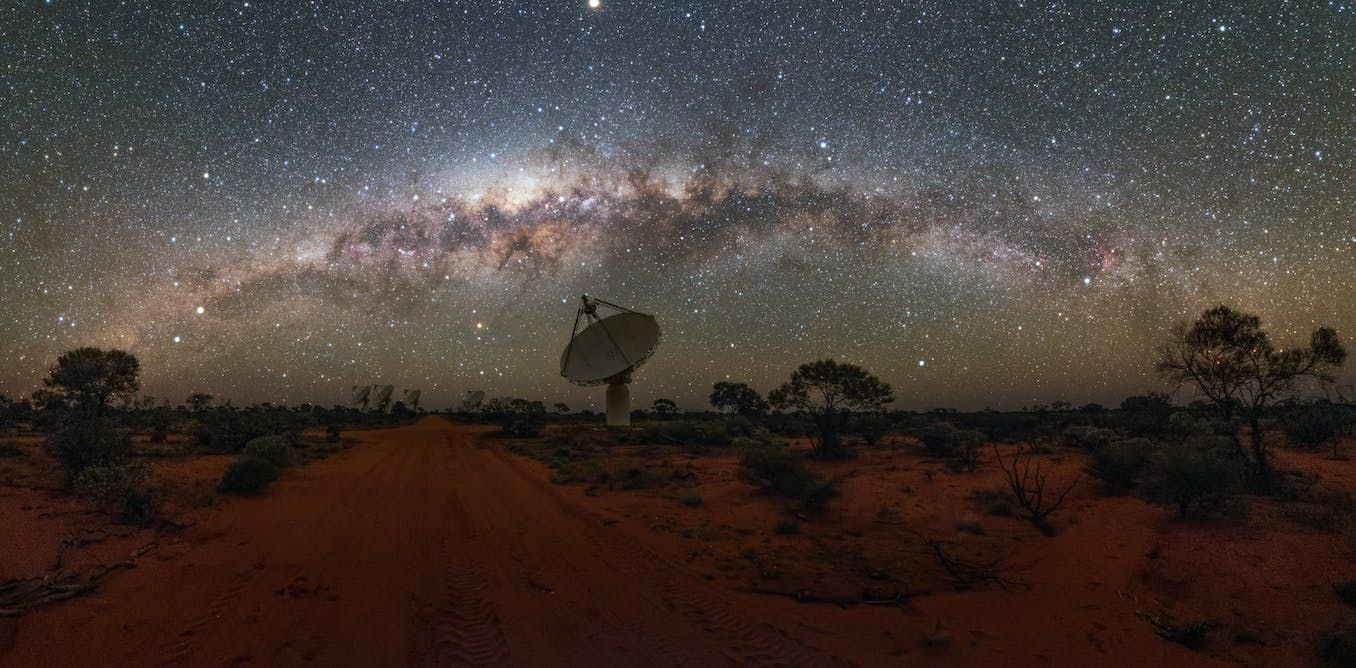We traced a powerful radio signal to the most distant source yet – a galaxy billions of lightyears away

Artist’s impression of a record-breaking Fast Radio Burst, passing from a distant host galaxy to the Milky Way. Image: ESO/M. Kornmesser
In summary
Analysis for The Conversation by Australian Research Council Future Fellow, Associate Professor Ryan Shannon
Every day and night, hundreds of thousands of intense, brief flashes of radiation suddenly flicker on and then off all across the sky. These “fast radio bursts” are invisible to the naked eye, but to a radio telescope many almost outshine everything else in the sky for a few thousandths of a second.
Since the first such burst was spotted in 2006, we have found that nearly all of them come from distant galaxies. Most bursts pass unnoticed, occurring outside the field of view of radio telescopes, and never occur again.
In new research published in Science, we have found the most distant fast radio burst ever detected: an 8-billion-year-old pulse that has been travelling for more than half the lifetime of the universe.
Seizing the opportunity
Astronomers are fascinated by fast radio bursts for two reasons.
The first is that their cause is unknown. The bursts are a trillion times more energetic than the things that look most like them: rotating neutron stars called pulsars, in our own galaxy.
The second reason is that the bursts provide a new tool to study other aspects of the cosmos.
Fast radio bursts let us study the “cosmic web” of matter floating in the space between galaxies. This matter is very hot, diffuse gas and almost invisible, but it subtly slows down fast radio bursts as they pass through it. (This is ordinary matter, the same kind that makes up stars, planets and humans, not the invisible “dark matter” that also lurks throughout the universe.)
The degree to which bursts slow down correlates with the distance they have travelled.
In 2020, analysis of fast radio bursts revealed that the cosmic web actually contains more than half of the normal matter in the universe – which astronomers had previously thought was “missing”.

The Australian Square Kilometre Array Pathfinder (ASKAP), the radio telescope used to discover and localise FRB 20220610A. Image: CSIRO
In search of the extreme
More distant and extreme fast radio bursts promise to reveal further secrets about the universe, so astronomers are on the hunt. I lead a team doing just that, using the Australian SKA Pathfinder (ASKAP) radio telescope.
On June 6 2022, our team detected and pinpointed a very bright burst with a high degree of slowing (known officially as “FRB 20220610A”). Our initial calculations suggested it might be the most distant ever found.
However, there was a possibility that the burst was closer than we thought – or that it might come from a distant galaxy too faint to be seen with an optical telescope.
We turned to one of the world’s most powerful optical observatories to search for the host galaxy: the Very Large Telescope (VLT) in Chile. The observatory’s four telescopes are equipped with cutting-edge cameras and spectrographs that can identify faint host galaxies and study their properties in detail.
At the position pinpointed by ASKAP as the source of the burst, initial images revealed faint smudges of light that looked like a distant galaxy. Analysing the spectrum of light from the galaxy showed it was strongly “redshifted”, meaning the emission from the burst has doubled in wavelength as it stretched out on its journey through the expanding universe.
The redshift had a value just over 1, which shows the burst was emitted more than 8 billion years ago, when the universe was less than half its present age. This confirmed that FRB 20220610A had broken the record for the most distant fast radio burst.

Host galaxy of FRB 20220610A, as observed by the Very Large Telescope in Red (R-band) optical light. The black circle shows the position of the FRB as measured by ASKAP. Image: Lachlan Marnoch (Macquarie Univesity/ASTRO-3D)
Pushing the limits of the universe
Like Olympic athletes, astronomers (including me) enjoy breaking records. Beyond personal satisfaction, however, this detection can also be used to explore the two fundamental questions about fast radio bursts.
First, the burst has the most energy of any that has been securely pinpointed to a location. It is more energy than our Sun puts out in 30 years, and approaches what we believe are fundamental physical limits.
The upper limit on the amount of energy any one fast radio burst can carry may be determined by quantum mechanical effects. At a certain point, the burst’s surge of radio photons may meet resistance from a sea of “virtual” electrons and positrons which British physicist Paul Dirac predicted in 1930.
Our discovery also demonstrates the potential for fast radio bursts to study the composition of the distant universe. As we look back in time, we see the structure of galaxies changes a great deal. Bursts in distant galaxies may allow us to study the detailed structure of their hosts.
Delving deeper in the cosmos
We now know that energetic bursts exist in the distant universe. As new and upgraded telescopes join the hunt for fast radio bursts, we are likely to see many more tracked down to their host galaxies.
We are currently building a new fast radio burst search system for ASKAP which will make it five times more sensitive, enabling us to push the frontier of our research further out into the universe.
And in the future, ultra-sensitive radio telescopes such as the Square Kilometre Array (SKA) will be able to detect bursts at ever greater distances. These detections will be used to map the structure of the universe and resolve the tale of a modern astronomical mystery.
This article was originally published on The Conversation.
-
Media Enquiries
Related articles
-

- Technology
- Science
- Engineering
Victorian students drive green energy transition through international hydrogen competition
Swinburne’s KIOSC, in collaboration with Horizon Educational and Gippsland Tech School, co-hosted the Hydrogen Grand Prix in Melbourne.Friday 26 July 2024 -

- Technology
- Health
New MedTechVic prototypes to transform everyday lives of people with a disability
Swinburne’s MedTechVic has revealed three new prototypes designed through the joint Health-led Manufacturing Innovation Program, in partnership with the Australian Medtech Manufacturing Centre and Safer Care Victoria
Friday 19 July 2024 -

- Astronomy
High school students work with Swinburne astronomers on the future of space
Swinburne’s Youth Space Innovation Challenge has inspired over 330 Australian teenagers to pursue a career in STEM.
Friday 26 July 2024 -

- Business
- Technology
Swinburne’s Luminate Pitch Night 2024 advances innovative ideas for a better world
Swinburne’s 2024 Luminate Pitch Night showcased market-ready ideas from 10 founders
Wednesday 12 June 2024 -

- Health
- Technology
Clinical Innovation Fellowships develop creative solutions to Australia’s healthcare challenges
MedTechVic is gearing up to begin its fourth year of the Clinical Innovation Fellowship Program (CIFP), following the highly successful third round in 2023.
Wednesday 19 June 2024

